NASA is indicating that a new regime of inspections will be required for its fleet of space shuttle to start flying again. In the case of Columbia, it’s believed that a hairline crack only a few centimeters long was created when a chunk of foam from its fuel tank smashed into its wing. NASA administrator Sean O’Keefe said that it’s going to take an “extremely meticulous” inspection system to catch this kind of problem for future flights. When launches do resume, they will be daytime flights only, so cameras can monitor the shuttle’s flight to orbit. The shuttle may return to flight in December or some time in 2004.
Russian Cargo Vessel Arrives at Station
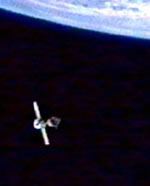
Image credit: NASA
A Russian Progress 11 cargo ship arrived at the International Space Station today, after spending three days catching up to it in orbit. The Progress reached the station at 1115 GMT (7:15am EDT) and docked automatically to the Pirs Docking Compartment on the Zvezda Service Module. On board the ship is more than two tonnes of food, fuel, water, supplies and scientific gear. This makes a total of three ships docked to the space station, including another Progress ship and the Soyuz that delivered the current crew.
An unmanned Russian resupply craft successfully docked to the International Space Station this morning, delivering more than two tons of food, fuel, water, supplies and scientific gear to the Expedition 7 crew aboard the complex.
The Progress 11 vehicle automatically linked up to the Pirs Docking Compartment attached to the Zvezda Service Module over Central Asia at 6:15 a.m. Central time (1115 GMT) three days after its launch from the Baikonur Cosmodrome in Kazakhstan. As the Progress neared Pirs for docking, Expedition 7 Commander Yuri Malenchenko and NASA ISS Science Officer Ed Lu were in Zvezda, monitoring its approach. At the time of contact and capture, the ISS was flying over Central Asia at an altitude of 240 statute miles. After conducting leak checks to insure a tight seal between the Progress and the ISS, Malenchenko and Lu will open the hatch to the ship and begin to unload its cargo.
Stowed in the Progress are replacement parts for environmental systems in both the U.S. and Russian segments of the Station, office supplies, two tanks of potable water, and some clothing items for the two crewmembers. Also aboard the Progress are two experiment kits for European Space Agency cosmonaut Pedro Duque, who will launch in October on the Soyuz TMA-3 vehicle with the Expedition 8 crew for about a week?s worth of scientific research on the ISS under a contract between ESA and the Russian Aviation and Space Agency. Duque will return to Earth with Malenchenko and Lu in the Soyuz TMA-2 vehicle currently docked to the Station.
The arrival of the new Progress puts three Russian vehicles at the ISS. Docked to the aft port of Zvezda is the Progress 10 resupply craft that arrived at the Station on February 4, and docked to the Zarya Module is the Soyuz TMA-2 vehicle that brought Malenchenko and Lu to the ISS on April 28.
Original Source: NASA News Release
Neutron Star’s Magnetism Measured for the First Time
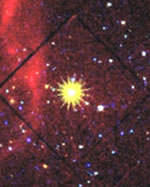
Image credit: ESA
Using the space-based XMM-Newton X-Ray observatory astronomers with the European Space Agency have made the first direct measurement of a neutron star’s magnetic field. A neutron star is a very dense object with the mass of a large star packed into a radius of only 20-30 km, and they were predicted to have very strong magnetic fields which acted like a brake, slowing down their rotation. But after observing a neutron star called 1E1207.4-5209 for over 72 hours with the XMM, the astronomers discovered that it was 30 times weaker than they were predicting. What causes these objects to slow down is once again a mystery.
Using the superior sensitivity of ESA’s X-ray observatory, XMM-Newton, a team of European astronomers has made the first direct measurement of a neutron star’s magnetic field.
The results provide deep insights into the extreme physics of neutron stars and reveal a new mystery yet to be solved about the end of this star?s life.
A neutron star is very dense celestial object that usually has something like the mass of our Sun packed into a tiny sphere only 20?30 km across. It is the product of a stellar explosion, known as a supernova, in which most of the star is blasted into space, but its collapsed heart remains in the form of a super-dense, hot ball of neutrons that spins at a incredible rate.
Despite being a familiar class of object, individual neutron stars themselves remain mysterious. Neutron stars are extremely hot when they are born, but cool down very rapidly. Therefore, only few of them emit highly energetic radiation, such as X-rays. This is why they are traditionally studied via their radio emissions, which are less energetic than X-rays and which usually appear to pulse on and off. Therefore, the few neutron stars which are hot enough to emit X-rays can be seen by X-ray telescopes, such as ESA?s XMM-Newton.
One such neutron star is 1E1207.4-5209. Using the longest ever XMM-Newton observation of a galactic source (72 hours), Professor Giovanni Bignami of the Centre d’Etude Spatiale des Rayonnements (CESR) and his team have directly measured the strength of its magnetic field. This makes it the first ever isolated neutron star where this could be achieved.
All previous values of neutron star magnetic fields could only be estimated indirectly. This is done by theoretical assumptions based on models that describe the gravitational collapse of massive stars, like those which lead to the formation of neutron stars. A second indirect method is to estimate the magnetic field by studying how the neutron star?s rotation slows down, using radio astronomy data.
In the case of 1E1207.4-5209, this direct measurement using XMM-Newton reveals that the neutron star?s magnetic field is 30 times weaker than predictions based on the indirect methods.
How can this be explained? Astronomers can measure the rate at which individual neutron stars decelerate. They have always assumed that ‘friction’ between its magnetic field and its surroundings was the cause. In this case, the only conclusion is that something else is pulling on the neutron star, but what? We can speculate that it may be a small disc of supernova debris surrounding the neutron star, creating an additional drag factor.
The result raises the question of whether 1E1207.4-5209 is unique among neutron stars, or it is the first of its kind. The astronomers hope to target other neutron stars with XMM-Newton to find out.
Note to editors
X-rays emitted by a neutron star like 1E1207.4-5209, have to pass through the neutron star?s magnetic field before escaping into space. En route, particles in the star?s magnetic field can steal some of the outgoing X-rays, imparting on their spectrum tell-tale marks, known as ‘cyclotron resonance absorption lines’. It is this fingerprint that allowed Prof. Bignami and his team to measure the strength of the neutron star?s magnetic field.
Original Source: ESA News Release
Flattest Star Ever Discovered
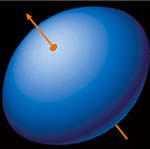
Image credit: ESO
Astronomers with the European Southern Observatory have discovered a star which is extremely flat All rotating objects in space are flattened due to their rotation; even our Earth is 21 kilometres wider at the equator than it is pole-to-pole. But this new star, called Achernar, is 50% wider at its equator than at its poles. Obviously it’s spinning quickly, but its shape doesn’t fit into the current astrophysics models. It should be losing mass into space at the rate it’s going. Time for some new models.
To a first approximation, planets and stars are round. Think of the Earth we live on. Think of the Sun, the nearest star, and how it looks in the sky.
But if you think more about it, you realize that this is not completely true. Due to its daily rotation, the solid Earth is slightly flattened (“oblate”) – its equatorial radius is some 21 km (0.3%) larger than the polar one. Stars are enormous gaseous spheres and some of them are known to rotate quite fast, much faster than the Earth. This would obviously cause such stars to become flattened. But how flat?
Recent observations with the VLT Interferometer (VLTI) at the ESO Paranal Observatory have allowed a group of astronomers [1] to obtain by far the most detailed view of the general shape of a fast-spinning hot star, Achernar (Alpha Eridani), the brightest in the southern constellation Eridanus (The River).
They find that Achernar is much flatter than expected – its equatorial radius is more than 50% larger than the polar one! In other words, this star is shaped very much like the well-known spinning-top toy, so popular among young children.
The high degree of flattening measured for Achernar – a first in observational astrophysics – now poses an unprecedented challenge for theoretical astrophysics. The effect cannot be reproduced by common models of stellar interiors unless certain phenomena are incorporated, e.g. meridional circulation on the surface (“north-south streams”) and non-uniform rotation at different depths inside the star.
As this example shows, interferometric techniques will ultimately provide very detailed information about the shapes, surface conditions and interior structure of stars.
VLTI observations of Achernar
Test observations with the VLT Interferometer (VLTI) at the Paranal Observatory proceed well [2], and the astronomers have now begun to exploit many of these first measurements for scientific purposes.
One spectacular result, just announced, is based on a series of observations of the bright, southern star Achernar (Alpha Eridani; the name is derived from “Al Ahir al Nahr” = “The End of the River”), carried out between September 11 and November 12, 2002. The two 40-cm siderostat test telescopes that served to obtain “First Light” with the VLT Interferometer in March 2001 were also used for these observations. They were placed at selected positions on the VLT Observing Platform at the top of Paranal to provide a “cross-shaped” configuration with two “baselines” of 66 m and 140 m, respectively, at 90? angle, cf. PR Photo 15a/03.
At regular time intervals, the two small telescopes were pointed towards Achernar and the two light beams were directed to a common focus in the VINCI test instrument in the centrally located VLT Interferometric Laboratory. Due to the Earth’s rotation during the observations, it was possible to measure the angular size of the star (as seen in the sky) in different directions.
Achernar’s profile
A first attempt to measure the geometrical deformation of a rapidly rotating star was carried out in 1974 with the Narrabri Intensity Interferometer (Australia) on the bright star Altair by British astronomer Hanbury Brown. However, because of technical limitations, those observations were unable to decide between different models for this star. More recently, Gerard T. Van Belle and collaborators observed Altair with the Palomar Testbed Interferometer (PTI), measuring its apparent axial ratio as 1.140 ? 0.029 and placing some constraints upon the relationship between rotation velocity and stellar inclination.
Achernar is a star of the hot B-type, with a mass of 6 times that of the Sun. The surface temperature is about 20,000 ?C and it is located at a distance of 145 light-years.
The apparent profile of Achernar (PR Photo 15b/03), based on about 20,000 VLTI interferograms (in the K-band at wavelength 2.2 ?m) with a total integration time of over 20 hours, indicates a surprisingly high axial ratio of 1.56 ? 0.05 [3]. This is obviously a result of Achernar’s rapid rotation.
Theoretical implications of the VLTI observations
The angular size of Achernar’s elliptical profile as indicated in PR Photo 15b/03 is 0.00253 ? 0.00006 arcsec (major axis) and 0.00162 ? 0.00001 arcsec (minor axis) [4], respectively. At the indicated distance, the corresponding stellar radii are equal to 12.0 ? 0.4 and 7.7 ? 0.2 solar radii, or 8.4 and 5.4 million km, respectively. The first value is a measure of the star’s equatorial radius. The second is an upper value for the polar radius – depending on the inclination of the star’s polar axis to the line-of-sight, it may well be even smaller.
The indicated ratio between the equatorial and polar radii of Achernar constitutes an unprecedented challenge for theoretical astrophysics, in particular concerning mass loss from the surface enhanced by the rapid rotation (the centrifugal effect) and also the distribution of internal angular momentum (the rotation velocity at different depths).
The astronomers conclude that Achernar must either rotate faster (and hence, closer to the “critical” (break-up) velocity of about 300 km/sec) than what the spectral observations show (about 225 km/sec from the widening of the spectral lines) or it must violate the rigid-body rotation.
The observed flattening cannot be reproduced by the “Roche-model” that implies solid-body rotation and mass concentration at the center of the star. The failure of that model is even more evident if the so-called “gravity darkening” effect is taken into account – this is a non-uniform temperature distribution on the surface which is certainly present on Achernar under such a strong geometrical deformation.
Outlook
This new measurement provides a fine example of what is possible with the VLT Interferometer already at this stage of implementation. It bodes well for the future research projects at this facility.
With the interferometric technique, new research fields are now opening which will ultimately provide much more detailed information about the shapes, surface conditions and interior structure of stars. And in a not too distant future, it will become possible to produce interferometric images of the disks of Achernar and other stars.
Original Source: ESO News Release
Survey Finds 1000 Variable Stars in Nearby Galaxy
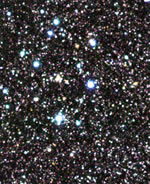
Image credit: ESO
An international survey by the European Southern Observatory has uncovered more than 1000 luminous red variable stars in nearby galaxy Centaurus A (aka NGC 5128). This is the first survey that’s ever been performed on a galaxy outside our own Milky Way. These stars, known as Mira-variables, pulse in a very specific way; the longer the cycle, the brighter they are – by comparing the visual brightness to their actual brightness, they can judge distances to these stars very accurately. This allows a very accurate measurement of the distance to Centaurus A.
An international team led by ESO astronomer Marina Rejkuba [1] has discovered more than 1000 luminous red variable stars in the nearby elliptical galaxy Centaurus A (NGC 5128).
Brightness changes and periods of these stars were measured accurately and reveal that they are mostly cool long-period variable stars of the so-called “Mira-type”. The observed variability is caused by stellar pulsation.
This is the first time a detailed census of variable stars has been accomplished for a galaxy outside the Local Group of Galaxies (of which the Milky Way galaxy in which we live is a member).
It also opens an entirely new window towards the detailed study of stellar content and evolution of giant elliptical galaxies. These massive objects are presumed to play a major role in the gravitational assembly of galaxy clusters in the Universe (especially during the early phases).
This unprecedented research project is based on near-infrared observations obtained over more than three years with the ISAAC multi-mode instrument at the 8.2-m VLT ANTU telescope at the ESO Paranal Observatory.
Mira-type variable stars
Among the stars that are visible in the sky to the unaided eye, roughly one out of three hundred (0.3%) displays brightness variations and is referred to by astronomers as a “variable star”. The percentage is much higher among large, cool stars (“red giants”) – in fact, almost all luminous stars of that type are variable. Such stars are known as Mira-variables; the name comes from the most prominent member of this class, Omicron Ceti in the constellation Cetus (The Whale), also known as “Stella Mira” (The Wonderful Star). Its brightness changes with a period of 332 days and it is about 1500 times brighter at maximum (visible magnitude 2 and one of the fifty brightest stars in the sky) than at minimum (magnitude 10 and only visible in small telescopes) [2].
Stars like Omicron Ceti are nearing the end of their life. They are very large and have sizes from a few hundred to about a thousand times that of the Sun. The brightness variation is due to pulsations during which the star’s temperature and size change dramatically.
In the following evolutionary phase, Mira-variables will shed their outer layers into surrounding space and become visible as planetary nebulae with a hot and compact star (a “white dwarf”) at the middle of a nebula of gas and dust (cf. the “Dumbbell Nebula” – ESO PR Photo 38a-b/98).
Several thousand Mira-type stars are currently known in the Milky Way galaxy and a few hundred have been found in other nearby galaxies, including the Magellanic Clouds.
The peculiar galaxy Centaurus A
Centaurus A (NGC 5128) is the nearest giant galaxy, at a distance of about 13 million light-years. It is located outside the Local Group of Galaxies to which our own galaxy, the Milky Way, and its satellite galaxies, the Magellanic Clouds, belong.
Centaurus A is seen in the direction of the southern constellation Centaurus. It is of elliptical shape and is currently merging with a companion galaxy, making it one of the most spectacular objects in the sky, cf. PR Photo 14a/03. It possesses a very heavy black hole at its centre (see ESO PR 04/01) and is a source of strong radio and X-ray emission.
During the present research programme, two regions in Centaurus A were searched for stars of variable brightness; they are located in the periphery of this peculiar galaxy, cf. PR Photos 14b-d/03. An outer field (“Field 1”) coincides with a stellar shell with many blue and luminous stars produced by the on-going galaxy merger; it lies at a distance of 57,000 light-years from the centre. The inner field (“Field 2”) is more crowded and is situated at a projected distance of about 30,000 light-years from the centre.
Three years of VLT observations
Under normal circumstances, any team of professional astronomers will have access to the largest telescopes in the world for only a very limited number of consecutive nights each year. However, extensive searches for variable stars like the present require repeated observations lasting minutes-to-hours over periods of months-to-years. It is thus not feasible to perform such observations in the classical way in which the astronomers travel to the telescope each time.
Fortunately, the operational system of the VLT at the ESO Paranal Observatory (Chile) is also geared to encompass this kind of long-term programme. Between April 1999 and July 2002, the 8.2-m VLT ANTU telescope on Cerro Paranal in Chile) was operated in service mode on many occasions to obtain K-band images of the two fields in Centaurus A by means of the near-infrared ISAAC multi-mode instrument. Each field was observed over 20 times in the course of this three-year period; some of the images were obtained during exceptional seeing conditions of 0.30 arcsec. One set of complementary optical images was obtained with the FORS1 multi-mode instrument (also on VLT ANTU) in July 1999.
Each image from the ISAAC instrument covers a sky field measuring 2.5 x 2.5 arcmin2. The combined images, encompassing a total exposure of 20 hours are indeed the deepest infrared images ever made of the halo of any galaxy as distant as Centaurus A, about 13 million light-years.
Discovering one thousand Mira variables
Once the lengthy observations were completed, two further steps were needed to identify the variable stars in Centaurus A.
First, each ISAAC frame was individually processed to identify the thousands and thousands of faint point-like images (stars) visible in these fields. Next, all images were compared using a special software package (“DAOPHOT”) to measure the brightness of all these stars in the different frames, i.e., as a function of time.
While most stars in these fields as expected were found to have constant brightness, more than 1000 stars displayed variations in brightness with time; this is by far the largest number of variable stars ever discovered in a galaxy outside the Local Group of Galaxies.
The detailed analysis of this enormous dataset took more than a year. Most of the variable stars were found to be of the Mira-type and their light curves (brightness over the pulsation period) were measured, cf. PR Photo 14i/03. For each of them, values of the characterising parameters, the period (days) and brightness amplitude (magnitudes) were determined. A catalogue of the newly discovered variable stars in Centaurus A has now been made available to the astronomical community via the European research journal Astronomy & Astrophysics.
Marina Rejkuba is pleased and thankful: “We are really very fortunate to have carried out this ambitious project so successfully. It all depended critically on different factors: the repeated granting of crucial observing time by the ESO Observing Programmes Committee over different observing periods in the face of rigorous international competition, the stability and reliability of the telescope and the ISAAC instrument over a period of more than three years and, not least, the excellent quality of the service mode observations, so efficiently performed by the staff at the Paranal Observatory.”
What have we learned about Centaurus A?
The present study of variable stars in this giant elliptical galaxy is the first-ever of its kind. Although the evaluation of the very large observational data material is still not finished, it has already led to a number of very useful scientific results.
Confirmation of the presence of an intermediate-age population
Based on earlier research (optical and near-IR colour-magnitude diagrams of the stars in the fields), the present team of astronomers had previously detected the presence of intermediate-age and young stellar populations in the halo of this galaxy. The youngest stars appear to be aligned with the powerful jet produced by the massive black hole at the centre.
Some of the very luminous red variable stars now discovered confirm the presence of a population of intermediate-age stars in the halo of this galaxy. It also contributes to our understanding of how giant elliptical galaxies form.
New measurement of the distance to Centaurus A
The pulsation of Mira-type variable stars obeys a period-luminosity relation. The longer its period, the more luminous is a Mira-type star.
This fact makes it possible to use Mira-type stars as “standard candles” (objects of known intrinsic luminosity) for distance determinations. They have in fact often been used in this way to measure accurate distances to more nearby objects, e.g., to individual clusters of stars and to the center in our Milky Way galaxy, and also to galaxies in the Local Group, in particular the Magellanic Clouds.
This method works particularly well with infrared measurements and the astronomers were now able to measure the distance to Centaurus A in this new way. They found 13.7 ? 1.9 million light-years, in general agreement with and thus confirming other methods.
Study of stellar population gradients in the halo of a giant elliptical galaxy
The two fields here studied contain different populations of stars. A clear dependence on the location (a “gradient”) within the galaxy is observed, which can be due to differences in chemical composition or age, or to a combination of both.
Understanding the cause of this gradient will provide additional clues to how Centaurus A – and indeed all giant elliptical galaxies – was formed and has since evolved.
Comparison with other well-known nearby galaxies
Past searches have discovered Mira-type variable stars thoughout the Milky Way, our home galaxy, and in other nearby galaxies in the Local Group. However, there are no giant elliptical galaxies like Centaurus A in the Local Group and this is the first time it has been possible to identify this kind of stars in that type of galaxy.
The present investigation now opens a new window towards studies of the stellar constituents of such galaxies.
Original Source: ESO News Release
Comets Survive Trip to the Sun
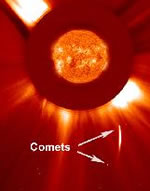
Image credit: SOHO
Comets usually don’t survive an encounter with the Sun, but SOHO captured images of a pair of extremely lucky comets that grazed the surface, well within the Sun’s fiery corona. It’s unusual for comets to travel in pairs like this, but what’s even more unusual is a faint puff of smoke emanating from the Sun at the point of the comets’ closest approach. It’s possible that the Sun evaporated the cloud of ice and dust away from the comets, essentially blasting their heads off. Studying this puff of dust may give astronomers additional clues about the composition of comets.
On May 24, 2003, a pair of comets arced in tandem towards the Sun, their path taking them to just 0.1 solar radii above the Sun’s surface, deep within the searing hot corona.
They belong to the Kreutz family of sun-grazing comets, often seen by SOHO while diving towards their final rendezvous with the Sun. But as in humans, twins are rare! Even more so, this pair showed another very unusual trait: What looks like a faint tail (or “puff of smoke”) can be seen moving away from the Sun, seemingly emanating from a point in the orbit beyond the comet’s closest approach! Normally, sungrazers simply fade and disappear at an earlier stage, obliterated by the intense heat and pressure.
Another pair of Kreutz sungrazers with such a “headless tail” was observed in June 1998 (see MPEG [ 677k] movie), when the observing geometry was very similar. But out of more than 600 sungrazing comets observed during more than six years by SOHO, this is only the third showing any signs of such behaviour!
The puff is most likely the dusty remains of the comet’s nucleus, being pushed out by the radiation pressure after all the ice in the nucleus has evaporated, thus eliminating the processes maintaining a bright coma surrounding the core. Studies of the dust cloud may reveal clues to the size distribution of the dust grains.
Comets are balls of dust and ice that zoom around space in elongated orbits. Their dust tails are pushed by the radiation pressure from the Sun. Their ion tails (usually fainter) are pushed away from the Sun by the solar wind. Both tails point away from the Sun, even for comets that are travelling back outwards in the solar system.
Original Source: SOHO News Release
Sea Launch Lofts Thuraya-2
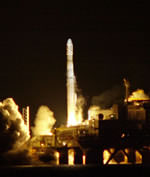
Image credit: Sea Launch
Sea Launch completed its eighth successful mission Tuesday morning with the launch of the Boeing-built Thuraya-2 satellite on board a Zenit-3SL rocket. Liftoff occurred at 1355 GMT (9:56 am EDT), and the satellite separated from the Block DM upper stage 90 minutes later. Thuraya will provide data, broadcast and telecommunication services to Europe, the Middle East, Africa and Asia. This was the first mission from Sea Launch in nearly a year, but the company expects another three launches this year.
Thuraya-2, the second satellite built by Boeing [NYSE:BA] for Thuraya Satellite Telecommunications Company of Abu Dhabi, United Arab Emirates, rocketed to geosynchronous transfer orbit today aboard a Zenit-3SL provided by Sea Launch Company, LLC.
The Boeing GEO-Mobile model satellite lifted off at 6:56 a.m. PDT (13:56 GMT) from the Odyssey Launch Platform positioned on the equator in the Pacific Ocean. The spacecraft separated from the launch vehicle approximately one hour and 40 minutes after the launch, and minutes later its first signals were received at a Telemetry, Tracking and Control Station at Uralla, Australia, confirming normal operation.
?The newest light in the heavens is Thuraya-2, a mobile communications satellite that will help connect users on the move within a vast area of the globe,? said Dave Ryan, president of spacecraft builder Boeing Satellite Systems International. ?A thorough check-out on orbit lies ahead for the satellite, and we are confident that it will soon take its place as a vital long-term asset supporting Thuraya?s future growth.?
Built in El Segundo, Calif., Thuraya-2 is designed to operate for 12 years at the 44 degrees East longitude orbital slot. The satellite will add capacity to the Thuraya network, which provides mobile voice and data communication services to a region of more than 100 countries in Europe, the Middle East, North and Central Africa, and Central and South Asia.
The Boeing Company is the world’s leading aerospace company, with its heritage mirroring the history of flight. It is the largest manufacturer of satellites, commercial jetliners and military aircraft. The company is also a global market leader in missile defense, human space flight and launch services.
Original Source: Boeing News Release
Rover Heads to Mars
NASA’s first Mars Explorer rover roared into space on Tuesday on board a Boeing Delta II rocket after two days of delays to poor weather, and some last minute glitches with ground tracking stations. The newly named rover, “Spirit”, will take seven months to reach Mars. Once it does arrive, the six-wheeled Spirit will land on the surface of the Red Planet, and begin exploring the surface searching for evidence of past water. The second rover, “Opportunity”, was originally expected to launch on June 25, but it might be also be delayed because Spirit’s launch was pushed back.
Foam Test Breaks Shuttle Panel as Expected
As predicted earlier in the week by Columbia accident investigators when a chunk of foam was fired at an actual space shuttle wing, it caused visible and significant damage. The foam was fired from a special pressurized gun at 234 metres per second, and when it struck the wing, it created a 7.5 centimetre crack in the carbon-fiber wing, and damaged several important T-seals. The test wing had actually been flown on space for 30 missions, so the experiment provided useful evidence to support the theory that foam damaged Columbia’s wing so that the shuttle couldn’t survive re-entry.
An initial foam impact test on a section of an orbiter reinforced carbon-carbon left-wing leading edge showed visible and significant damage on RCC panel 6 and the T-seal between RCC panels 6 and 7, the Columbia Accident Investigation Board reported today.
The foam-strike was part of a series of tests the CAIB is conducting at Southwest Research Institute to determine how a foam strike of the kind observed on Columbia’s launch might damage the RCC panels, T-seals, or their support structure. The tests were designed to bracket the observed impact region and conditions.
In today’s outdoor test, investigators fired a large block of foam from a pressurized nitrogen gun aimed at the lower side of left-wing RCC panel 6. The foam struck the panel directly on target and created a three-inch crack extending from a visible three-quarter inch damage area on the outside of the RCC to the RCC rib inside the wing. Later examination revealed that the T-seal between panels 6 and 7 was cracked as well. The strike also caused a shift in the position of RCC panel 6 and the T-seals on either side of that panel, and chipped a carrier panel on the upper side of the wing.
RCC panel 6 was an actual panel that flew 30 missions on Discovery, another Orbiter.
Foam details:
Weight: 1.68 lbs.
Dimensions: 21 3/8 inches x 11 9/16 inches x 5 5/8 inches
Volume: 1,390 cubic inches
Speed: 768 feet per second
Angle of incident: 20 degrees
The CAIB has not reached any final conclusions and has not determined the cause of the loss of the shuttle and crew. The board’s final report will be issued later this summer.
Original Source: CAIB News Release
Progress Launches to Resupply Space Station
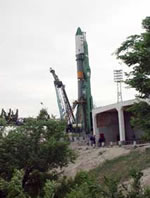
Image credit: Energia
An unmanned Russian Progress 11 cargo ship lifted off from the Baikonur Cosmodrome on Sunday, carrying more than two tonnes of food, fuel, water, supplies, and scientific equipment for the International Space Station. The Progress launched at 1043 GMT (6:34am EDT) and then reached orbit nine minutes later. It’s expected to reach the space station on Wednesday, where it will link up automatically with the Pirs Docking Compartment on the Zvezda Service Module.
An unmanned Russian resupply craft successfully blasted off from the Baikonur Cosmodrome in Kazakhstan today, carrying more than two tons of food, fuel, water, supplies and scientific gear for the Expedition 7 crew aboard the International Space Station.
The Progress 11 vehicle lifted off on time from its Central Asia launch pad at 5:34 a.m. Central time (1034 GMT, 2:34 p.m. Baikonur time). Less than nine minutes later the Progress settled into orbit, and moments later, its solar arrays and navigational antennas had been deployed. At the time of the Progress launch, Expedition 7 Commander Yuri Malenchenko and NASA ISS Science Officer Ed Lu were flying near the Equator off the west coast of Africa at an altitude of 240 statute miles.
After three days of pre-programmed engines firings to reach the ISS, the Progress will link up automatically to the Pirs Docking Compartment on the Station?s Zvezda Service Module on Wednesday at 6:17 a.m. Central time (1117 GMT). Within a few hours, Malenchenko and Lu will open the hatch to the ship and begin to unload its cargo.
Stowed in the Progress are replacement parts for environmental systems in both the U.S. and Russian segments of the Station, office supplies, two tanks of potable water, and some clothing items for the two crewmembers. Also aboard the Progress are two experiment kits for European Space Agency cosmonaut Pedro Duque, who will launch in October on the Soyuz TMA-3 vehicle with the Expedition 8 crew for about a week?s worth of scientific research on the ISS under a contract between ESA and the Russian Aviation and Space Agency. Duque will return to Earth with Malenchenko and Lu in the Soyuz TMA-2 vehicle currently docked to the Station.
Original Source: NASA News Release
